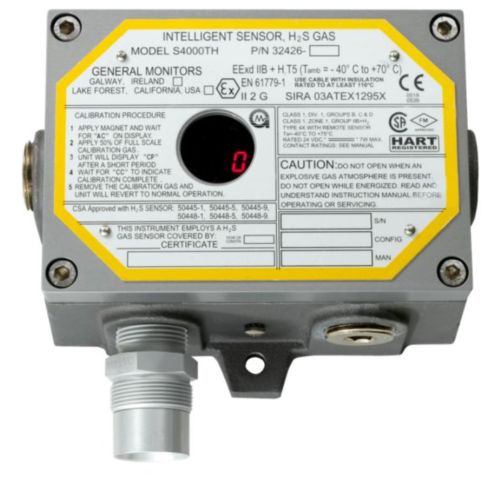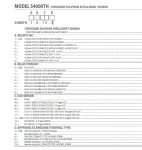The S4000TH is obsolete and has been replaced by the S5000 Gas Monitor, which offers enhanced performance and advanced features for H2S detection. The mounting footprint and cable entries of the two transmitters are identical, which makes retrofitting simple. To help with the transition to the latest technology, please refer to the white paper.
The S4000TH Intelligent Sensor is a microprocessor-based transmitter designed for use with General Monitors’ Metal Oxide Semiconductor (MOS) sensor. This unit features one-person calibration and can virtually self-calibrate by simply activating a magnetic switch and applying gas. It is designed to detect hydrogen sulfide in parts per million (ppm) levels and provide status indication and alarm outputs.
All of the S4000TH electronics are contained within an explosion-proof housing, allowing sensor information to be processed at the sensor site. It provides a 4-20 mA signal that is proportional to 0-100% of the sensor’s detection range. In addition, the S4000TH includes warning, alarm, and fault relay contacts that can be used to indicate an alarm or fault condition, as well as dual redundant Modbus or HART communications. Configurations with relays, Modbus and HART are available to meet many needs.
The S4000TH includes a three (3) digit LED display. This local digital display continuously indicates gas concentrations during normal operation and in calibration check mode, as well as prompts during calibration mode, displays codes during setup mode, and eight fault codes. The S4000TH has four different operating modes.
First, the normal operating mode in which alarms are active and the display and 4-20 mA readings are proportional to the gas concentration at the sensor. Second, the gas check mode enables the user to apply gas and verify the sensor response while alarm outputs are inhibited. Third, a calibration mode in which gas is applied to the sensor to calibrate the unit. Finally, a setup mode is available that allows users to review and modify setup options, including relay settings, sensor range, and Modbus parameters. Selecting Setup Mode on the S4000TH is accomplished by using the magnetic switch, HART or Modbus command.
Features
- H2S gas detection ranges (0-20 ppm, 0-50 ppm, 0-100 ppm).
- Event logging stores fault, gas check, calibration, and alarm event history.
- HART and Modbus communication provide complete status and control capability in the control room.
- Warning, alarm & fault relays provide local alarm capability.
- Calibration, calibration check, and setup mode simplify operation and maintenance.


